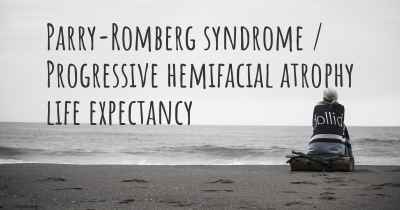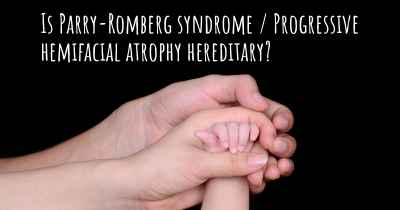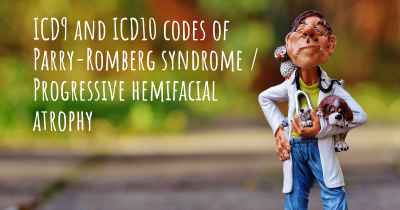Living with Parry-Romberg syndrome / Progressive hemifacial atrophy. How to live with Parry-Romberg syndrome / Progressive hemifacial atrophy?
Can you be happy living with Parry-Romberg syndrome / Progressive hemifacial atrophy? What do you have to do to be happy with Parry-Romberg syndrome / Progressive hemifacial atrophy? Living with Parry-Romberg syndrome / Progressive hemifacial atrophy can be difficult, but you have to fight to try to be happy. Have a look at things that other people have done to be happy with Parry-Romberg syndrome / Progressive hemifacial atrophy

Living with Parry-Romberg Syndrome / Progressive Hemifacial Atrophy
Parry-Romberg Syndrome, also known as Progressive Hemifacial Atrophy, is a rare condition characterized by the progressive wasting away of the tissues on one side of the face. This can lead to various physical and emotional challenges for individuals living with the syndrome. While there is no cure for Parry-Romberg Syndrome, there are strategies and support systems that can help individuals lead fulfilling lives.
Medical Management
It is crucial for individuals with Parry-Romberg Syndrome to work closely with a team of healthcare professionals, including dermatologists, neurologists, and plastic surgeons. Regular check-ups and consultations can help monitor the progression of the condition and manage any associated symptoms.
Treatment options for Parry-Romberg Syndrome are limited, but some individuals may benefit from interventions such as:
- Medications: Certain medications, such as immunosuppressants or corticosteroids, may be prescribed to manage inflammation and slow down the progression of the disease.
- Plastic surgery: Reconstructive procedures can help restore symmetry to the face and improve overall appearance. These surgeries may involve fat grafting, tissue transfer, or implants.
- Dental and orthodontic care: As Parry-Romberg Syndrome can affect the jaw and teeth, regular dental check-ups and orthodontic interventions may be necessary to maintain oral health.
Emotional Support
Living with Parry-Romberg Syndrome can have a significant impact on an individual's emotional well-being. Coping with changes in appearance and potential social stigma may require additional support. Here are some strategies to consider:
- Seeking therapy: Engaging in therapy, such as cognitive-behavioral therapy or support groups, can provide a safe space to express emotions, develop coping mechanisms, and gain support from others facing similar challenges.
- Building a support network: Surrounding yourself with understanding and empathetic friends, family, and support groups can help alleviate feelings of isolation and provide a sense of belonging.
- Self-care: Prioritizing self-care activities, such as exercise, hobbies, and relaxation techniques, can improve overall well-being and boost self-confidence.
Adapting Daily Life
Living with Parry-Romberg Syndrome may require some adjustments to daily routines and activities. Here are some practical tips to consider:
- Sun protection: As the affected skin may be more sensitive to sunlight, it is important to use sunscreen, wear protective clothing, and avoid excessive sun exposure.
- Vision and dental care: Regular eye exams and visits to the dentist can help identify and address any issues related to vision or dental health.
- Assistive devices: Depending on the severity of facial asymmetry, individuals may benefit from using assistive devices such as eyeglasses, contact lenses, or prosthetic aids to improve functionality and appearance.
- Education and awareness: Educating yourself and others about Parry-Romberg Syndrome can help reduce misconceptions and promote understanding and acceptance within your community.
Living a Fulfilled Life
While Parry-Romberg Syndrome presents unique challenges, it is important to remember that it does not define an individual's worth or potential. Here are some additional tips for living a fulfilled life:
- Focus on strengths: Identify and nurture your talents and passions. Engaging in activities that bring joy and fulfillment can help shift the focus away from physical appearance.
- Set realistic goals: Break down larger goals into smaller, achievable steps. Celebrate each milestone along the way, building confidence and a sense of accomplishment.
- Advocate for yourself: Be proactive in seeking appropriate medical care, support, and accommodations when needed. Your voice matters, and advocating for your needs can lead to improved quality of life.
- Connect with the community: Engage in volunteer work or advocacy efforts related to Parry-Romberg Syndrome. Connecting with others who share similar experiences can provide a sense of purpose and empowerment.
Remember, living with Parry-Romberg Syndrome requires resilience, self-compassion, and a supportive network. By focusing on overall well-being and embracing individual strengths, it is possible to lead a fulfilling life despite the challenges posed by this condition.
Posted Mar 4, 2017 by Hannah 1050
Posted Mar 4, 2017 by Barbara 1000
Once it is diagnosed, and is accepted the disease, you can go ahead and with the hope that medical science advances and be able to contribute to improving the quality of life of the patients..
Posted Oct 26, 2017 by Erika 200








